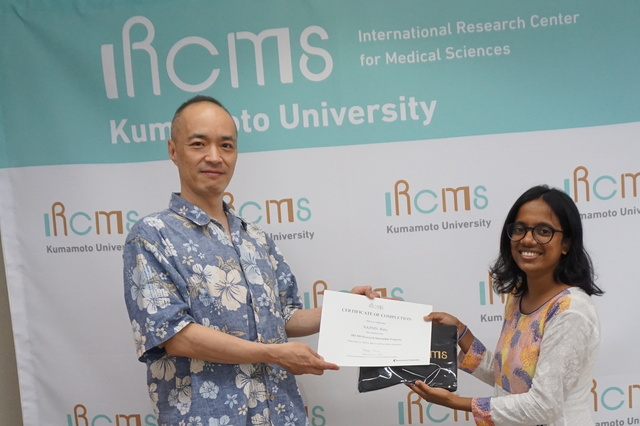- HOME
- Education
- Student's Voice
- 【IRCMS Internship】Ms. Baby Naznin (University of Dhaka)
Student's Voice

Name: Baby Naznin
University of Dhaka
Visiting Period: June 10th (Fri) - July 15th (Fri), 2022
Country: Bangladesh
Lab: Laboratory of Cancer Metabolism
Bacterial artificial chromosomes (BACs) are large genomic clones that are stably maintained in Escherichia coli. BAC are sufficiently large to contain entire gene and can be modified using recombination-based methods. Therefore, this technique can be adopted to manipulate gene expression in specific cell types.
Constructing BAC was the first learning target of my internship. Insertion of 5 arm and 3 arm into PL452 is the key step to make the construct. For that, PL452 and the 5 arm insert was digested using SalI and EcoRI.
To join the vector DNA and insert DNA, ligation was performed using ligase which is designated as PL452-5arm-Timer. Afterwards, transformation of the vector into competent E. coli is carried out following standard procedures. The plasmid DNA containg bacterial colony was picked through the growth capabiliy in kanamycin containing media. Those colonies were latter grown in LB medium for culturing. After overnigth growth, E. coli is centrifuged and the plasmid extraction and purification is done onwards. The sequence of PL452-5arm-Timer was confirmed using 3 primers: M13 reverse primer, 5arm seq1, and 5arm seq2. PL452-5arm-Timer and the 3 arm insert was further digested by BamHI and NotI and ligated the
Figure-1: 5 arm insert check
vector and insert by ligase enzyme. This is designated as PL452-PD1Timer targeting vector. Sequence of the 3 arm insert was later confirmed by using 3arm seq1 and 3arm seq2.
Figure-2: DNA band cutting from agarose gel
During all these procedures, necessary precautions were maintained. For example, all the restriction enzymes and plasmid handling steps were carried out on ice and the time for specific steps were strictly followed. The sequence data was checked and once it was found that one of the samples was not accordingly inserted with 5 arm. This was repeated to make the insertion again.
Other than constructing the BAC, I also had some experience on several other procedures that were ongoing in the laboratory. Cell passage and cell counting was a new technique for me to learn how to handle cell line. I also have been instructed about T7E assay.
Figure-3: Cell culture plate under microscope



